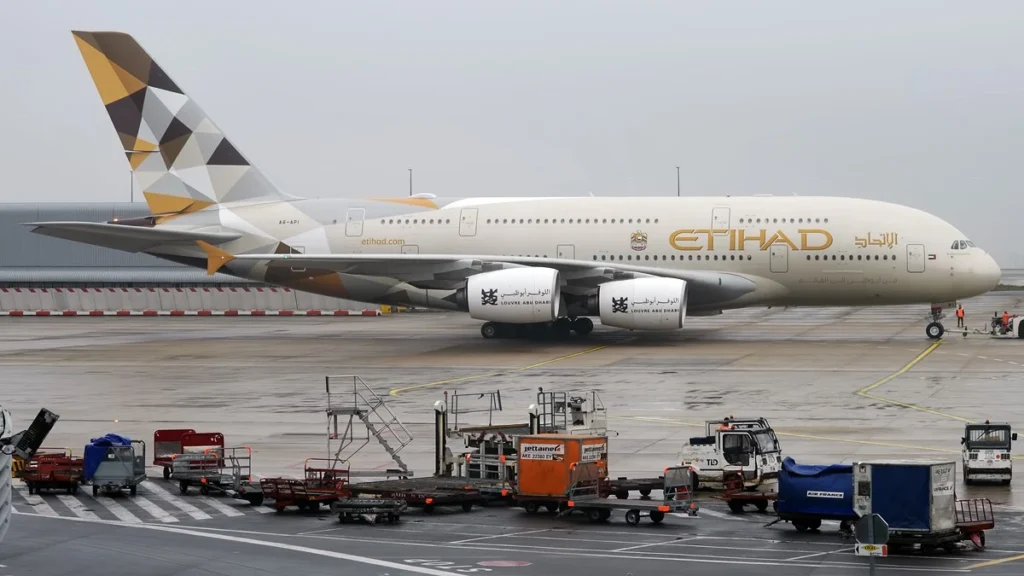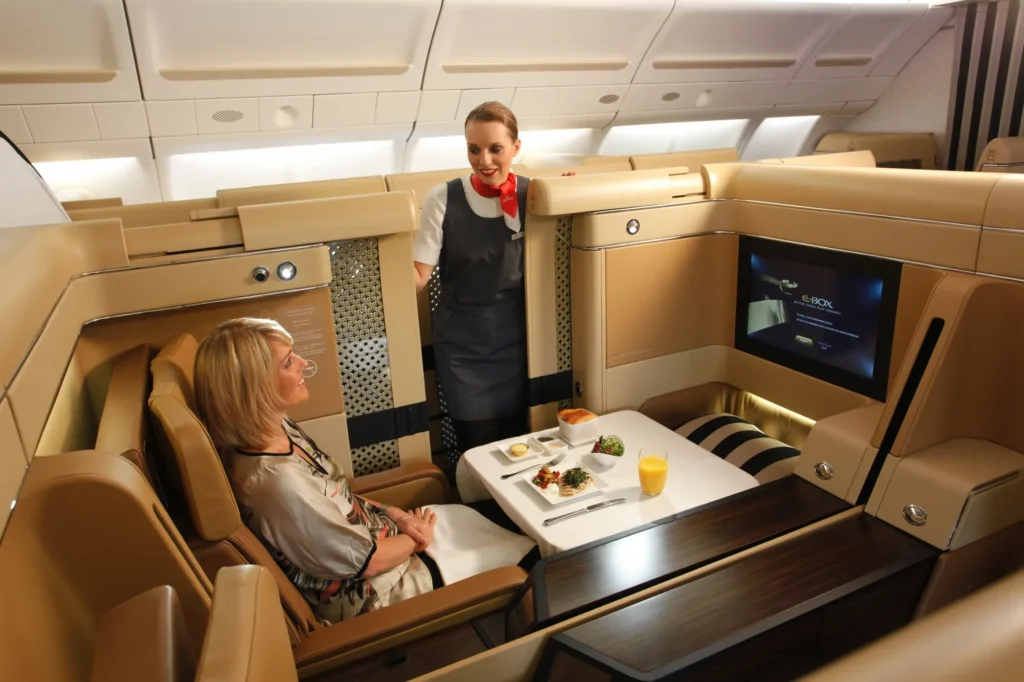ABU DHABI- Etihad Airways (EY) will deploy its Airbus A380 on flights between Zayed Abu Dhabi International (AUH) and Narita International (NRT) starting 16 June 2026. The shift brings higher capacity at the start of the peak Japan travel season.
The A380 introduction marks a significant boost for Etihad Airways as demand continues to grow on the Abu Dhabi to Tokyo (NRT) route.
 Photo: By Anna Zvereva from Tallinn, Estonia – Etihad Airways, A6-API, Airbus A380-861, CC BY-SA 2.0, https://commons.wikimedia.org/w/index.php?curid=67096356
Photo: By Anna Zvereva from Tallinn, Estonia – Etihad Airways, A6-API, Airbus A380-861, CC BY-SA 2.0, https://commons.wikimedia.org/w/index.php?curid=67096356
Etihad Plans A380 Flights to Tokyo
Etihad Airways will bring the A380 back into scheduled service on the Abu Dhabi to Tokyo route to meet rising passenger volumes and support strong business travel flows between the UAE and Japan. The move aligns with the airline’s broader strategy to enhance long-haul capacity across key global markets.
Tokyo will join Etihad’s existing superjumbo destinations that include London, Paris, Toronto and Singapore. Its return enables Etihad to expand seat availability on a route that has consistently performed well, both for business and leisure demand
The airline states that Japan remains a key market, supported by longstanding economic and cultural ties with the UAE.
The larger aircraft also supports inbound traffic, offering Japanese travellers improved access to Abu Dhabi as either a stopover or a primary destination. The decision reflects Etihad’s confidence in the market and the continued appetite for premium travel experiences.
Arik De, the Chief Revenue and Commercial Officer at Etihad Airways, stated:
As we bring our latest A380 back into service, we’re delighted to introduce our remarkable aircraft to Japan. Our guests consistently tell us they love the onboard experience. Our attentive cabin crew delivers dedicated service to every passenger, whether they’re travelling in Economy, Business, First or The Residence, our three-room suite in the sky.
We’ve seen strong demand from customers for more seats to Japan, and the A380 allows us to deliver that. The aircraft is particularly well-suited to this route, given the importance of business travel between the UAE and Japan, two nations with deep economic and cultural ties. Japan has always been a favourite destination for our guests, and this move reinforces our commitment to the market.”
Arik De, Chief Revenue and Commercial Officer, Etihad Airways
 Photo: By Mitchul Hope – Etihad Airways | A6-APB | Airbus A380-861 | London Heathrow Airport (LHR/EGLL), CC BY-SA 2.0, https://commons.wikimedia.org/w/index.php?curid=129305775
Photo: By Mitchul Hope – Etihad Airways | A6-APB | Airbus A380-861 | London Heathrow Airport (LHR/EGLL), CC BY-SA 2.0, https://commons.wikimedia.org/w/index.php?curid=129305775
Flight Schedule
Here’s a detailed flight schedule of Etihad’s flight from Abu Dhabi to Tokyo Narita with Airbus A380:
Flight NoDeparture AirportDeparture TimeArrival AirportArrival TimeFrequencyEY 0800Abu Dhabi AUH21:25Tokyo Narita NRT12:45DailyEY 0801Tokyo Narita NRT18:00Abu Dhabi AUH00:20Daily
 Etihad A380 First-Class; Photo- Etihad
Etihad A380 First-Class; Photo- Etihad
Premium Cabins and Onboard Highlights
The A380 offers a wide range of cabin products designed to elevate the long haul journey. First Class features nine First Apartments with generous seating, structured privacy, and an 80-inch lie-flat bed. Passengers have access to a dedicated shower room and personal vanity units.
Business Class includes 70 Business Studios arranged for comfort, privacy, and efficient workflow. The upper deck also features The Lobby, a staffed lounge and bar area situated between First and Business cabins. High-speed Wi-Fi is available across all cabins.
Economy travellers benefit from a dedicated welcome area and a mix of extra legroom and standard Economy Smart seats. Seventy seats provide increased pitch, and 337 Smart seats offer improved ergonomics with fixed wing headrests and larger pillows.
 Photo: Etihad
Photo: Etihad
The Residence Experience
The Residence sits at the top of Etihad’s A380 offering. It is the only three room suite in commercial aviation, designed for up to two guests who want full privacy and personalised service.
The space includes a private living room, bedroom, and ensuite bathroom with an in-flight shower.
Passengers in The Residence receive dedicated crew attention throughout the journey. Dining is presented with an a la carte menu, designer tableware, and the option to dine in the living room or bedroom. Champagne, caviar, and The Residence Signature High Tea complete the premium service proposition.
 Photo: United
Photo: United
Tokyo Travel Guide
Tokyo captures first-time visitors with its fast pace and deep sense of history. Travelers arriving at Haneda Airport (HND) or Narita Airport (NRT) step into a city that blends neon avenues with quiet temple paths.
The city’s districts stretch out in every direction, each offering its own character, food culture, and traditions. This guide outlines the essential highlights for planning a first visit and navigating Tokyo with confidence.
 Tokyo Haneda Airport; Photo- Wikipedia
Tokyo Haneda Airport; Photo- Wikipedia
Exploring a City Built on Contrasts
Tokyo rewards exploration. Historic shrines stand a short walk from towers of glass and steel, while landscaped gardens sit behind some of the busiest train stations in the world. The city’s appeal lies in discovering how these opposites work together.
Start at Shibuya Crossing, where streams of pedestrians move under giant screens. Nearby, Shibuya Sky gives a full sweep of the skyline and draws photography enthusiasts day and night. Meiji Shrine offers calm just minutes away, reached via a shaded forest path that feels worlds away from the crowds of Harajuku and its trend-driven backstreets.
Zojo-ji Temple rests at the foot of Tokyo Tower. The temple grounds mix quiet walkways and memorials with views of the tower rising above the wooden halls. Asakusa’s Senso-ji sits at the end of Nakamise Street, where visitors stop for melon pan, senbei or matcha ice cream before exploring the neighborhood’s retro atmosphere.
Shinjuku brings another side of the city. Godzilla peeks from a rooftop, department stores stretch for blocks, and alleys like Omoide Yokocho fill with yakitori stalls after dark. At sunrise, Toyosu Market hosts sushi counters such as Sushi Dai, where chefs prepare fish brought in hours earlier.
Gotokuji Temple, known for its thousands of maneki neko figurines, is best visited early for a peaceful walk. In contrast, Ginza offers polished architecture, Kabuki-za Theater, and refined cafés. TeamLab Planets in Toyosu leads visitors barefoot through digital art and reflective spaces that merge color, movement, and water.
Hamarikyu Gardens provides a traditional teahouse and views of the surrounding high-rises. Visitors can experience sumo practice in the morning through guided tours that give a close look at wrestler routines. Roppongi combines museum visits, galleries, and top-floor city views. The Imperial Palace Gardens offer a quiet counterpart to Tokyo’s skyscrapers.
Kappabashi, known as Kitchen Town, caters to anyone drawn to knives, cookware, or the city’s famous plastic food displays. Karaoke clusters across Shinjuku and Shibuya, where private rooms can be rented by the hour. The Yamanote Line loops around the city, connecting many of the major stops that define a visitor’s first trip.
 Tokyo City; Photo- derrickbrutel | Flickr
Tokyo City; Photo- derrickbrutel | Flickr
Districts Worth Slowing Down For
Omotesando blends design, luxury storefronts, and the calm of the Nezu Museum’s garden. Daikanyama and Ebisu provide leafy streets, cafés, and small galleries. Shimokitazawa draws night owls with thrift shops and live music. Yanaka preserves an older, slower Tokyo with wooden houses and neighborhood stalls. Kichijoji pairs Izakaya culture with Inokashira Park and a lively arts scene.
Amazake Yokocho offers a short walk through traditional sweets shops and stalls serving taiyaki and senbei. Akihabara remains a landmark for electronics, retro gaming, and themed cafés. Hands-on activities include calligraphy at Sip & Shodo, rail simulators at the Tokyo Metro Museum, and cooking classes that introduce local ingredients and techniques.
Cherry blossom season paints the city pink from late March to early April. Mount Takao, about an hour from Shinjuku, offers a manageable hike with temple stops and views of Mount Fuji. Don Quijote stores showcase everything from snacks to quirky gifts.
Public baths, both sento and onsen, provide calm but require familiarity with etiquette, from washing before entering to keeping towels out of the water. Capsule hotels appeal to travelers curious about minimal, tech-driven lodging.
 Photo:Basile Morin | Wikimedia Commons
Photo:Basile Morin | Wikimedia Commons
https://commons.wikimedia.org/wiki/File:Green_and_yellow_taxi_at_night_in_Yasukuni-dori_Avenue,_Shinjuku,_Tokyo.jpg
Where to Stay
Tokyo’s hotel landscape spans luxury towers, modern boutique stays, and traditional ryokan. Options include Aman Tokyo, The Okura Tokyo, Trunk Hotel Yoyogi Park, Hyatt House Shibuya, Muji Hotel Ginza, Hamacho Hotel, The Barn Tokyo, Park Hyatt Tokyo, Tokyo Station Hotel, Yuen Bettei Daita, Sawanoya Ryokan, and Hoshinoya Tokyo. Each offers its own blend of design, location, and service style.
Safety and Tips for Solo Travelers
Tokyo remains safe for individuals traveling alone. Women-only train cars help with comfort during rush hours. Solo diners are welcome at ramen counters and izakaya bars.
Basic Japanese phrases help in smaller neighborhoods. Police support is easy to access through local koban stations.
 Photo: Passenger Terminal Today
Photo: Passenger Terminal Today
Food and Drink: From Street Snacks to Fine Dining
Tokyo’s dining scene runs from neighborhood soba shops to celebrated omakase counters. Highlights include Edosoba Hosokawa, Kappa Nakajima, Butter Baby, Jade5, Kyubey, Parklet, Setsuko Juice and Breakfast, Fukudaya, Usagi Ramen, Citron, Seirinkan, Higashiya Man, Sunday Bake Shop and Streamer. Upscale options include Ukai-tei, Sézanne, Florilège and Sushiya Ono.
Bars and cafés across the city cater to craft cocktail fans, natural wine drinkers and beer enthusiasts. Notable spots include The SG Club, The Bellwood, No. 501, The Roof, Virtù Bar, Watering Hole, Janai Coffee, Little Soul, Bar Trench, Mikkeller Bar, The Peak Lounge and Bar and BenFiddich.
Convenience stores such as 7-Eleven, Lawson and Family Mart supply grab-and-go meals, coffee, smoothies, clothing basics and Japan’s signature novelty snacks. A visit becomes part of the Tokyo routine rather than a simple stop.
Stay tuned with us. Further, follow us on social media for the latest updates.
Join us on Telegram Group for the Latest Aviation Updates. Subsequently, follow us on Google News


AloJapan.com